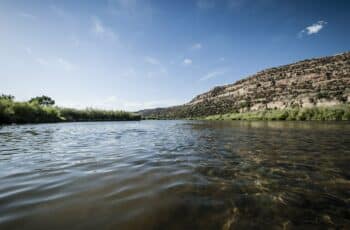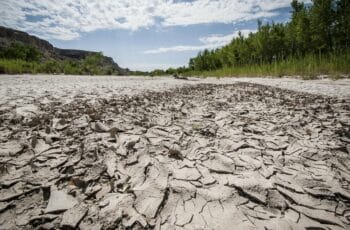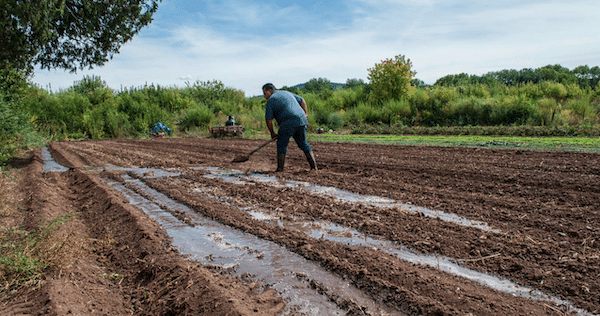The sunflowers behind Conjunto Preschool in Española, New Mexico, are still inedible.
The soils that they sprout from are saturated with tetrachloroethene. The water poured by preschoolers, receiving some of their first lessons in gardening around these raised beds, is contaminated with trichloroethylene.
More than two decades ago, byproducts from cleaning supplies flowed from a local dry cleaner and laundromat into Española’s sole groundwater aquifer, the only source of drinking water for the town’s 10,000 residents. The contaminants also trickled into individual wells, a key water source for the Santa Clara Pueblo tribe’s 2,400 members.
For eighteen years, the fifty-eight-acre North Railroad Avenue Plume Superfund site underwent studies, treatments, and reviews at the direction of the U.S. Environmental Protection Agency (EPA). In 2019, cleanup and maintenance duties were transferred to the state’s hands. To this day, according to Beata Tsosie, a member of the Santa Clara Pueblo, their water remains affected.
“Humans are an indicator species for the health of the environment, especially Indigenous people,” says Tsosie, the organizational director of Breath of My Heart Birthplace, a free midwifery care clinic and birth center in Española. Tsosie is also involved in Indigenous and environmental advocacy work.
“We’ve seen cancers, we’ve seen miscarriages, we’ve seen birth defects—the burden of proof of the harm [is] falling on us as one of the most impacted communities,” she adds.
Yet these school garden sunflowers continue to grow. And, if they had not been deemed “unacceptable risks to human health” by EPA guidelines, their seeds, stems, leaves, and petals could have been used in local recipes and healthy meals. Until then, the community continues to hope for a future brimming with cleaner, healthier New Mexico waters—a vision that last May, when the U.S. Supreme Court ruled in 5 to 4 favor of Sackett v. EPA, turned all the more hazy.

Blue waters in Navajo Dam. (Photo: Jim O’Donnell)
The Clean Water Act’s scope shrunk significantly as a result of the ruling, which removed federal protections for America’s small streams and wetlands that do not run with water year-round or are disconnected from major waterbodies.
No state lost more than New Mexico, where an arid climate and mountainous geography make seasonal flows, isolated basins, and small channels the norm. Overnight, 96 percent of the state’s waterways—which in addition to supplying water for drinking and sanitation support the economies of subsistence fishers, growers, and a $2.4 billion outdoor recreation industry—were left federally unguarded, vulnerable to pollution and unregulated usage.
Making matters worse, says Rachel Conn, the deputy director of Amigos Bravos, a freshwater-focused environmental nonprofit in Taos, New Mexico, is a well-intentioned yet unprepared state government. The New Mexico Water Quality Act (NMWQA), a strong piece of state-level legislation, is the last safeguard standing for a majority of the state’s waters. Yet currently, it’s more bark than bite with virtually no infrastructure to support and enforce it.
“We don’t have a state program, we don’t have the regulations set, we don’t have the staff hired, we don’t have the systems in place to implement its protections,” Conn says.
So we’re left really vulnerable to unregulated discharges of pollution into our waterways.
New Mexico is one of only two states without a surface water permitting program, and one of three states that lacks the authority to issue National Pollutant Discharge Elimination System (NPES) permits under the Clean Water Act. Officials estimate between $43 million and $54 million would be needed annually to support such a program. A significant victory was achieved this past January, when the state legislature approved the Land of Enchantment Legacy Fund with bipartisan support. The fund’s $300 million appropriation is the state’s first-ever consistent and long-term funding source for water and stream conservation.
But how and if the funds are allocated and used across New Mexico’s departments and communities remains to be seen. For the sake of its waters, the state has only a short window to get its act together. In roughly five years’ time, the current EPA-issued permits that regulate discharge and pollution—in mining, construction, or other development-oriented enterprises—will expire.
“That’s kind of the point we expect to see a lot of permits drop off,” Conn says.
It’s hard to monitor projects that go forward without a paper trail.
In April, New Mexico’s water worries featured prominently in the American Rivers Association’s annual “Most Endangered Rivers of 2024” report. It was a unique yet necessary decision to give the top spot to the entirety of the state’s riparian ecosystem, says Matt Rice, the association’s southwest regional director.
While a majority of New Mexico’s freshwater flows in its four largest rivers—the Rio Grande, the Gila, the San Juan, and the Pecos—there is virtually no part of the state’s vast watershed that is unconnected. High-elevation wetlands filter snowmelt into cool headwaters that flow into tributaries and channels, eventually proceeding to rivers’ main stems. But these alpine ecosystems, which act as water-purifying sponges, are no longer protected due to the Supreme Court’s decision. What begins in the mountains cascades down to surface water, crop fields, sinks, and showers.
“If there’s pollution going into one part of the watershed, it’s going to end up in the main stem, where there are structures that divert surface water for drinking,” Conn says.
If the water is dirtier, it is going to be more expensive to treat, and [that] will be a huge financial burden on New Mexico communities.
In May, New Mexico’s government released a new Climate Adaptation and Resilience Plan, outlining its intentions to strengthen water infrastructure, supply systems, and treatment facilities. The report also included dismal weather forecasts that these goals would need to overcome: statewide average temperature increases of between 3 degrees Fahrenheit and 5 degrees Fahrenheit, and from 5 to 10 percent less precipitation in all but a few counties by 2050.
“We no longer use the word ‘drought,’ because it suggests that there’s an end,” Rice says.
This is a different world, this is the aridification of the West. The climate crisis is a water crisis.
“Temperature is considered a pollutant,” Conn adds.

A dried up riverbed in the San Juan Basin watershed. (Photo: Jim O’Donnell)
New Mexico’s current hydrology and its leadership’s actions have the potential to be a blueprint for states like Arizona, Nevada, Utah, and parts of Colorado. “If we can demonstrate to the Western United States that a diverse group of people, organizations, and interests can get together and protect rivers of natural, cultural, and community value, we can do anything,” Rice says.
And it isn’t just the West watching. Drier summers and milder winters across the country are already demoting full-time flows to weaker or part-time trickles. In February, a study of North American rivers published in Science found that 40 percent of the continent’s northern rivers, and 18 percent of its central rivers, are experiencing a “significant decrease in river flow seasonality.”
New Mexico is the last U.S. state with a citizen’s legislature, meaning that its lawmakers receive no salary and tend to step down at the end of their respective terms. This June, both the Senate (20 seats) and House (28 seats) chambers are up for election, setting up a major shake-up at a time when bipartisan partnership and prioritizing of water is needed more than ever.
“When everyone was talking about Flint, Michigan, it’s like, ‘We have that here, too,’” says Demis Foster, the executive director of Conservation Voters New Mexico, a nonpartisan nonprofit dedicated to informing voters and holding leaders accountable on matters of the environment.
This is a very heartfelt issue here, and we have a lot of young people running for office who have watched their community suffer. It gives me hope that we have real community people running.
Across party lines and in both rural and urban counties, water is a top concern for New Mexico’s voters. According to a 2024 Colorado College State of the Rockies poll, 88 percent of the state’s respondents said that poor water quality due to old infrastructure or pollutants was a serious problem, and 96 percent said low river flows were an extremely serious problem. In the poll’s 2023 edition, 83 percent of New Mexicans said they “support requiring local governments to determine whether there is enough water available before approving new residential development projects.”
The next state legislature session, which lasts 60 days in odd-numbered years, opens in January 2025. For the sake of the state’s waters, Foster says, not a minute can afford to be wasted.
“We have to be ready with some kind of state rulemaking and policy that we can get put in place immediately,” she says.
So we have a water coalition in New Mexico now that is working really intensely on how we can put the policy together. These new candidates are going to be key to getting that done for us.
The effects of both climate and policy changes are felt first and most intimately at the local level.
In Northern New Mexico, these impacts are expected to endanger the health of acequias—surface-water community ditches that collect and divert freshwater from headwaters and streams, and have been prevalent in rural communities since Spanish colonizers and settlers introduced the practice in the 1600s. In the years since, these have become crucial social and environmental pillars within New Mexican culture and economies, providing small ranchers and growers with the water they need to water fields, grow crops, and raise livestock.
“Acequias are fundamental cornerstones of New Mexico’s history and culture, they’re important and beautiful components of life and water rights across generations,” Conn says.
Those dependent on these shared ditches, which have offered families and low-income residents cost-effective access to water for generations, will now face the real possibility of their contamination.
Though acequias aren’t the only water-distribution solution, they also are not ubiquitously appreciated. Indigenous growers know there used to be a greater balance between the use of irrigation ditches and dryland farming techniques that are less water-intensive, such as rainwater catchment, earthwork building, contour farming, and food forest ecologies. In the past, these growing practices withstood times of pre-colonization drought.
But Tsosie has observed an increased number of irrigation systems in her Santa Clara Pueblo, a legacy of Spanish influence. Here, the history of New Mexico’s hydrology has been reflected by the hardiness of her community’s seeds.
“There’s a possibility that some of our seeds may have gotten spoiled by having an abundance of water,” she says.
But we still have a lot of dryland seeds that grow only with rainwater.
The resurgence of these older growing methods may prove vital for small-time farmers, both Indigenous and non, whose only water supplies are now doubly endangered by pollution and drought. The possibility of relying on city water systems and state-led testing programs is both uncertain and potentially expensive, sparking questions that New Mexico’s government will need to answer soon.
“The cost to farmers, if contamination in our water and sewage systems is found, is going to be huge,” Tsosie says.
How are we going to adapt and switch over to different technologies? Is crop sampling [for toxic chemicals] going to be available? Are we going to have to pay for that?
Christian Thorsberg is a writer from Chicago and graduate student at Northwestern’s Medill School of Journalism.

